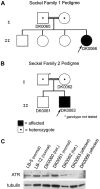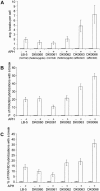Chromosomal instability at common fragile sites in Seckel syndrome
- PMID: 15309689
- PMCID: PMC1182052
- DOI: 10.1086/422701
Chromosomal instability at common fragile sites in Seckel syndrome
Abstract
Seckel syndrome (SCKL) is a rare, genetically heterogeneous disorder, with dysmorphic facial appearance, growth retardation, microcephaly, mental retardation, variable chromosomal instability, and hematological disorders. To date, three loci have been linked to this syndrome, and recently, the gene encoding ataxia-telangiectasia and Rad3-related protein (ATR) was identified as the gene mutated at the SCKL1 locus. The ATR mutation affects splicing efficiency, resulting in low levels of ATR in affected individuals. Elsewhere, we reported increased instability at common chromosomal fragile sites in cells lacking the replication checkpoint gene ATR. Here, we tested whether cells from patients carrying the SCKL1 mutation would show increased chromosome breakage following replication stress. We found that, compared with controls, there is greater chromosomal instability, particularly at fragile sites, in SCKL1-affected patient cells after treatment with aphidicolin, an inhibitor of DNA polymerase alpha and other polymerases. The difference in chromosomal instability between control and patient cells increases at higher levels of aphidicolin treatment, suggesting that the low level of ATR present in these patients is not sufficient to respond appropriately to replication stress. This is the first human genetic syndrome associated with increased chromosome instability at fragile sites following replication stress, and these findings may be related to the phenotypic findings in patients with SCKL1.
Figures




References
Electronic-Database Information
-
- Online Mendelian Inheritance in Man (OMIM), http://www.ncbi.nlm.nih.gov/Omim/ (for SCKL, Nijmegen breakage syndrome, and LIG4 syndrome)
References
-
- Abou-Zahr F, Bejjani B, Kruyt FAE, Kurg R, Bacino C, Shapira SK, Youssoufian H (1999) Normal expression of the Fanconi anemia proteins FAA an FAC and sensitivity to mitomycin C in two patients with Seckel syndrome. Am J Med Genet 83:388–39110.1002/(SICI)1096-8628(19990423)83:5<388::AID-AJMG9>3.0.CO;2-1 - DOI - PubMed
-
- Blount BC, Mack MM, Wehr CM, MacGregor JT, Hiatt RA, Wang G, Wickramasinghe SN, Everson RB, Ames BN (1997) Folate deficiency causes uracil misincorporation into human DNA and chromosome breakage: implications for cancer and neuronal damage. Proc Natl Acad Sci USA 94:3290–329510.1073/pnas.94.7.3290 - DOI - PMC - PubMed
Publication types
MeSH terms
Substances
Grants and funding
LinkOut - more resources
Full Text Sources
Other Literature Sources
Miscellaneous

